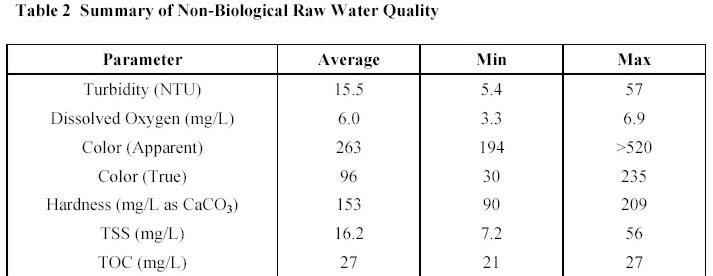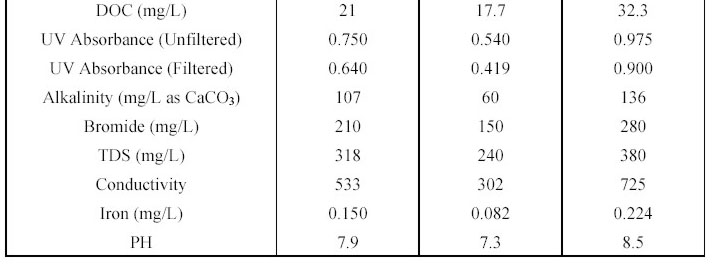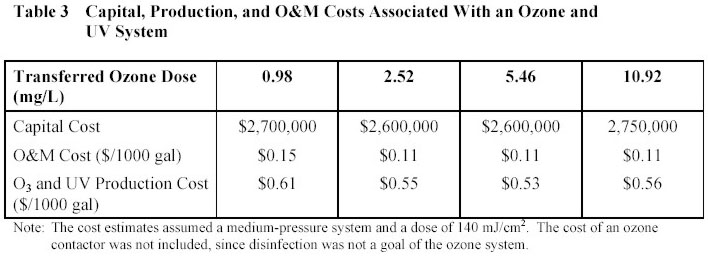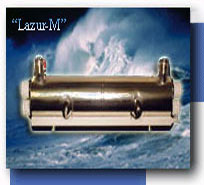 |


|
|
Synergies of Ultraviolet Disinfection and Ozone in Water Treatment 
Abstract
Two case studies outlining the benefits of using ozone and Ultraviolet are presented in this paper. They demonstrate the
cost effectiveness and robustness that can be observed when the synergies of these two treatment alternatives are
utilized. In the first study, ozone and Ultraviolet disinfection were used at the Weber Basin Water Conservancy District’s
Water Treatment Plant No. 3. The ozone system was designed to improve pretreatment, control taste and odor
(T&O) compounds, and provide an additional Giardia barrier, while Ultraviolet was used to provide 2-log of
Cryptosporidium inactivation. The capital cost savings obtained by using this option, as opposed to using ozone
alone, were nearly 50%. In the second study, the effectiveness of ozone and Ultraviolet were assessed on the challenging
water of Lake Okeechobee. With the goal of meeting all US Primary and Secondary Drinking Water Standards, the
data analysis indicated that a combination of ozone and Ultraviolet disinfection would result in the most cost-effective
option. The use of ozone to reduce color and decrease Ultraviolet transmittance (UltravioletT) resulted in substantial cost savings
by decreasing the ozone dose over what would be required to achieve Cryptosporidium disinfection and allowing for
the elimination of an ozone contactor. Furthermore, the increase in UltravioletT that was observed resulted in a smaller Ultraviolet
system, thereby reducing the cost of the overall system even further.
Keywords
Cryptosporidium; ozone; synergy; Ultraviolet disinfection; Ultraviolet transmittance INTRODUCTION
Ozone is widely used in the drinking water treatment industry to meet multiple treatment
objectives, including: disinfection, T&O removal, color removal, iron and manganese control,
and removal of organic matter (when combined with biologically active filters). It is well known
that ozone is effective for the inactivation of Cryptosporidium; however, the ozone dose required
to achieve a given inactivation is dependent on water quality and especially temperature. The
CT required to achieve 2-log of Cryptosporidium inactivation increases by a factor of
approximately 10 as the temperature decreases from 20 0C to 1 0C (Rennecker et. al., 1999).
Disinfection with ultraviolet (Ultraviolet) light is an emerging technology for Cryptosporidium
inactivation. This paper discussed process synergies that were observed in two studies when
using both ozone and Ultraviolet processes in the treatment train to achieve long-term regulatory
compliance. WEBER BASIN WATER TREATMENT PLANT NO. 3
Weber Basin WTP No. 3 was a conventional WTP that used GAC and disinfection with free
chlorine. In planning for the expansion from 26 mgd to 46 mgd, the following process
alternatives were considered: low-pressure membrane filtration, ozone disinfection (with a
hydraulic residence time of 30 minutes and a CT of 15 mg/L-m), Ultraviolet disinfection with a dosage
of 50 mJ/cm2, and the combination of ozone and Ultraviolet processes. Process selection was driven by
a regulatory analysis in which criteria for compliance with existing and future regulations were
developed. These criteria included achieving compliance with existing regulations for Giardia and virus inactivation, and for anticipated regulation requiring Cryptosporidium inactivation /
removal. In addition, goals were established for THMs and HAA-5 at 40µg/L and 30 µg/L,
respectively, and a finished water turbidity goal of 0.07 NTU. Criteria was also established for
secondary regulations, such as taste and odor. Initially, the process recommendation was to select
ozone to meet the multiple treatment objectives. By doing so, the plant would be able to provide
for the following:
• T&O control
• Improvement of DBP precursor removal when used in conjunction with biologically active
filters
• Eliminate the need for GAC
• Cryptosporidium inactivation
Initial design criteria were developed which indicated that a hydraulic retention time (HRT) of
30 minutes and a CT of 15 mg min/L would be sufficient to provide for 2-log Cryptosporidium
inactivation at 2 0C. However, subsequently published literature indicated that the inactivation of
Cryptosporidium was more challenging and that an HRT of 40 minutes and a CT of 38 mg min/L
would be required at 2 0C. These revised design criteria effectively doubled the capital cost of
the ozone facilities and subsequently made the ozone alternative a less feasible option. Based on
this development, the feasibility of ozone and Ultraviolet in the process train was evaluated. Using this
concept, the goals for ozone were:
• T&O control
• Additional Giardia barrier
• Improved pre-treatment with the use of pre-ozonation
In contrast, the treatment goal for Ultraviolet disinfection was to provide 2-log of Cryptosporidium
removal.
Based on this treatment alternative, new cost estimates were developed. The cost estimate for
the ozone and Ultraviolet option are compared to the cost estimates for ozone alone in Table 1.

In the alternatives analysis, a number of benefits of the ozone / Ultraviolet process combination were
identified. These included:
• The ozone / Ultraviolet combination provides multiple barriers for Cryptosporidium and Giardia
• Ozonation increases the Ultraviolet transmittance of waters and thereby reduces operating and
capital costs of the downstream Ultraviolet system
• Disinfection efficiency of Ultraviolet light is not strongly temperature dependent and offers
additional disinfection credit at lower water temperatures
• Ultraviolet provides a disinfection against sloughed biofilm from biologically active filters
Based on the cost effectiveness and the benefits listed above, the Weber Basin Water
Conservancy District selected the ozone and Ultraviolet disinfection option. The plant expansion design
has been completed and construction is expected to be finished sometime in 2003.
CERP ASR PILOT STUDY
Carollo Engineers was selected by the U.S. Army Corps of Engineers (USACE) and the South
Florida Water Management District (SFWMD) to conduct a pilot study as part of their
Comprehensive Everglades Restoration Project (CERP). CERP is an $8 billion project designed
to capture freshwater from Lake Okeechobee, that would otherwise be diverted to the ocean
through canals, and direct it back into the Everglades ecosystem for restoration. This particular
project evaluated potential options to treat Lake Okeechobee water for an aquifer storage and
recovery (ASR) program that will ultimately include over 300 wells with an ultimate treatment
capacity of over 1.5 billion gallons per day (bgd). During dry months, this water will then be
pumped from the ASR wells and directed back to the Everglades.
Given the challenging water quality characteristics of Lake Okeechobee (Table 2), Carollo
Engineers, in collaboration with ASR Systems, University of South Florida, and EET, proposed
the use of bank filtration followed by ozonation and/or Ultraviolet disinfection to meet the requirement
of all U.S. Primary and Secondary Drinking Water Standards. This unconventional treatment
train was selected because it produces no residuals, has little (if any) chemical requirements, and
offered a multiple barrier approach to pathogen control.
 
The pilot process train consisted of a simulated bank filtration system where the filter effluent
was directed to two parallel processes: ozonation and Ultraviolet disinfection (an Aquionics medium
pressure system). Near the end of the study, the system was reconfigured to test ozonation and
Ultraviolet disinfection in series.
An analysis of the data was performed and the results indicated that due to the treatment
requirements, a system comprised of both ozone and Ultraviolet disinfection would result in the most
cost-effective solution. This conclusion was due, in part, because of the high organic content of
the Lake Okeechobee water. Pilot testing indicated that the oxidant demand of the water was so
large as to render disinfection with ozone impractical. Furthermore, the high Ultraviolet transmittance
(UltravioletT) of the water would require the use of large Ultraviolet systems, resulting in a prohibitively
expensive disinfection process. As a result, cost estimates were developed based on an ozone
and Ultraviolet disinfection system that would use the advantages of both technologies to address the
regulatory requirements of the project. In order to accomplish this in a cost-effective manner,
the ozone system would be designed to treat the high color of the water and to increase UltravioletT,
thereby resulting in a smaller and less expensive Ultraviolet system required to meet the disinfection
challenges. The use of ozone in this way resulted in a smaller ozone system, in addition to
eliminating the need for an expensive ozone contactor, since long HRTs would not be required to
obtain disinfection credit using ozone.
Cost estimates based on the transferred ozone dose were determined from quotes provided by the
equipment suppliers. The estimates are provided in Table 3.

CONCLUSIONS
The synergies of ozone and Ultraviolet disinfection result in a robust treatment process that is capable of
treating a wide range of water quality issues and meeting multiple regulatory requirements. In
addition, the complementary mechanisms of each process can result in significant savings in both
capital and operation and maintenance (O&M) costs when they are designed to meet a particular
goal. At the Weber Basin Water Conservancy District’s WTP No. 3, these synergies were
exploited to result in an approximate 50% savings, when compared to the use of ozone alone.
This was achieved through the design of a smaller ozone system to treat T&O compounds,
improve pretreatment and serve as a barrier to Giardia. In contrast, the Ultraviolet disinfection system
was designed to obtain the required Cryptosporidium inactivation credit.
Similarly, the advantages of ozone and Ultraviolet disinfection were observed in the CERP ASR project.
The high organic content of Lake Okeechobee translated into a high-colored water, with low
UltravioletT and a very high oxidant demand. These characteristics precluded the use of either ozone or
Ultraviolet alone to meet the desired finished water quality goals. The results of the study indicated that
optimal treatment and reduced cost would be observed by using both ozone and Ultraviolet disinfection.
Sizing of the ozone system to decrease the color of the water and increase the UltravioletT resulted in
substantial capital and O&M savings by decreasing the size of the ozone system, eliminating the
need for an ozone contactor, as well as reducing the size of the Ultraviolet disinfection system.
REFERENCES
Rennecker, J.L.; Marinas, B.J., Rice, E.W., Owens, J.H. (1999). Inactivation of Cryptosporidium
parvum Oocysts with Ozone. Wat. Res. 33 (11), 2481-2488.


|
